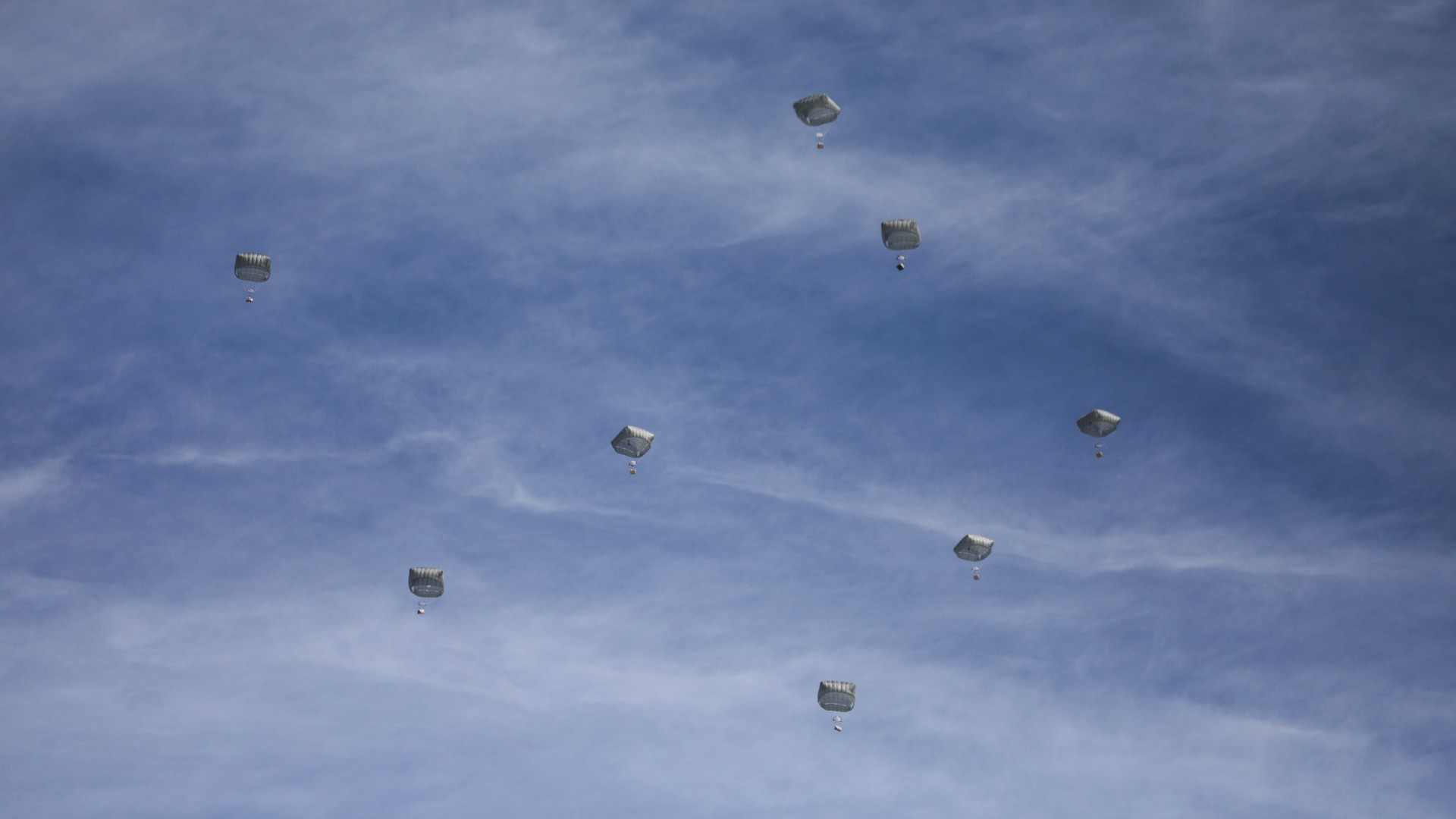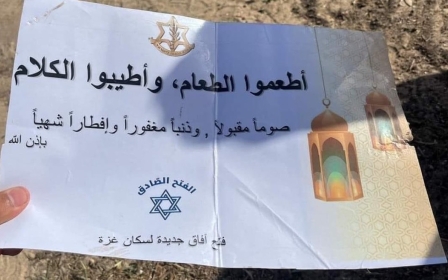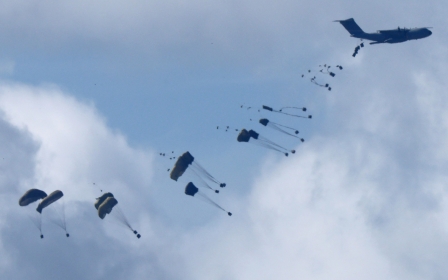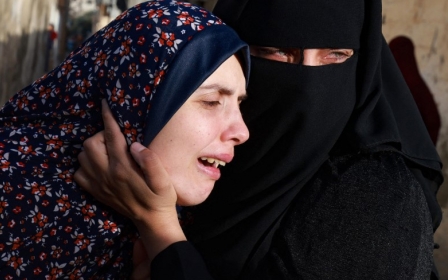War on Gaza: Why air-dropping aid on Gaza is doing more harm than good
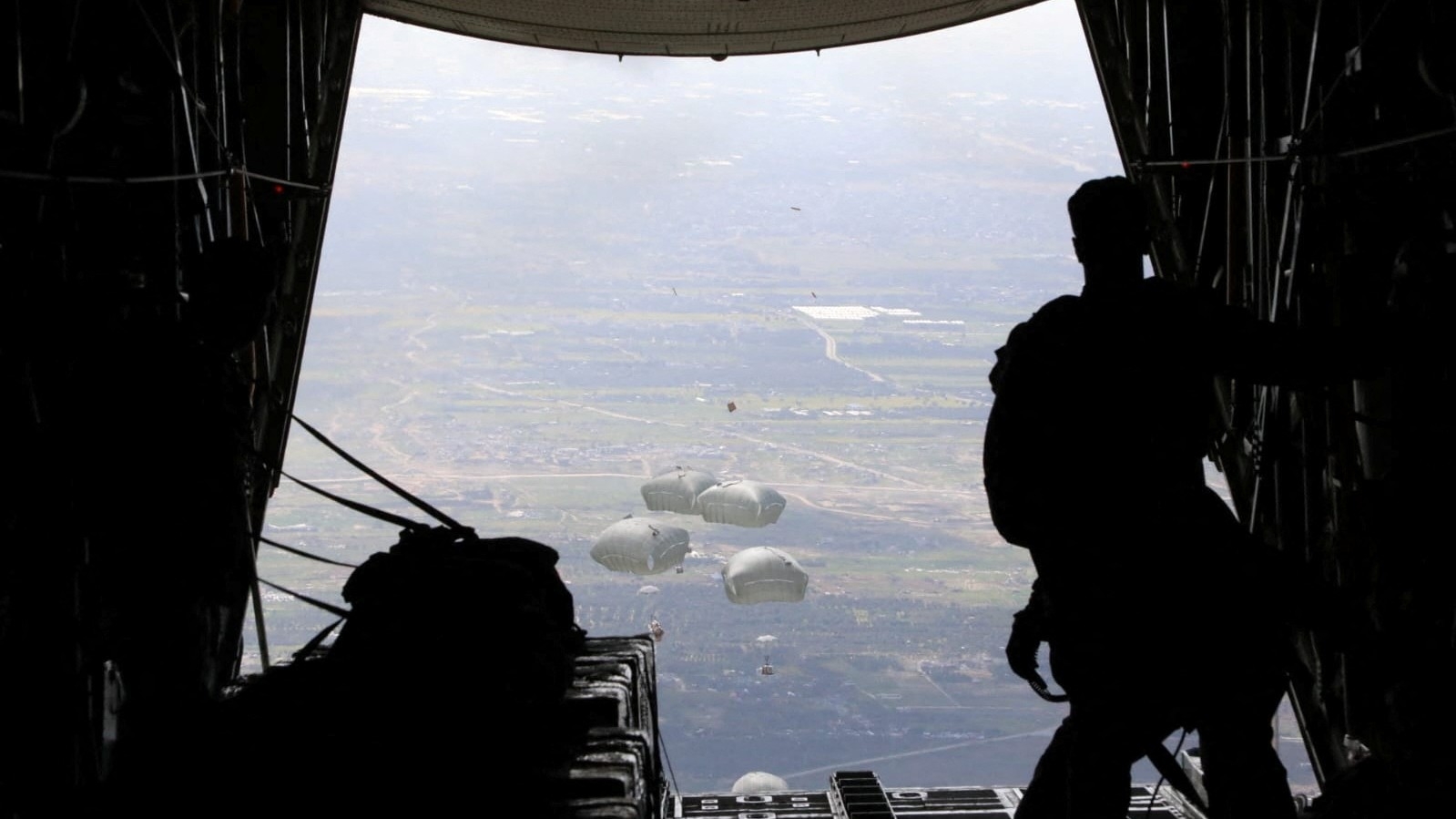
Images of US, French and Jordanian planes dropping pallets of aid from high altitude and crates of meals being parachuted into Gaza have garnered a lot of attention in recent days.
However, as the humanitarian situation in Gaza deteriorates, questions have been raised on whether air-dropping is the best solution.
On Friday, five Palestinians were killed and several wounded after a parachute landing a humanitarian air-drop load failed to open, bringing a pallet crashing down into a crowd of people waiting for food north of Gaza City's Shati refugee camp.
The Palestinian Ministry of Health has stated that at least 20 Palestinians in Gaza have died since the start of the war due to dehydration and malnutrition, with several aid organisations warning that the number will grow if urgent action is not taken.
The air-drops have come almost five months into Israel's war on Gaza, which has resulted in more than 30,900 dead and over 70,457 wounded in the besieged enclave.
Stay informed with MEE's newsletters
Sign up to get the latest alerts, insights and analysis, starting with Turkey Unpacked
Palestinians have told Middle East Eye that the air-drops are "pointless" in the face of widespread starvation, particularly as, over the past week, videos of the drops showed the aid landing into the sea or in parts of Israel.
As well as being dehumanising to Palestinians, experts have noted critical issues related to air-dropping aid, which is often used as a last resort when no other options are feasible.
1. Stampedes and injury
Air-dropping aid can in some cases result in stampedes, as masses of people desperate for food run in the same direction towards the crates or pallets.
Without the coordination of organisations, such as the World Food Programme or the UN, to manage numbers and organise people to ensure a fair distribution and that the most in need receive aid, air-drops can leave people at further risk.
In some cases, the air-dropped aid can also cause injury to people on the ground.
Scott Paul, the head of humanitarian policy for Oxfam America, said that more air-drops in Gaza could put people in danger.
"Chaos and violence are more likely as basic goods run out and social order breaks down after enduring months of violence and hunger," he said, adding that the first rule with air-drops must always be "do no harm".
"The scenes at the al-Rashid Road aid delivery yesterday, where over 100 people were killed, illustrate the need for careful planning, coordination and security for aid delivery amid such desperation," he said.
On 29 February, more than 100 Palestinians were killed when Israeli forces opened fire on a crowd of thousands of hungry people waiting for an aid delivery by land, media reports said.
However, Gaza's government media office has denounced the air-drops as "useless" after they killed five Palestinians, calling them “flashy propaganda rather than a humanitarian service" and urging that food be allowed through land crossings.
2. No guarantee of where it ends up
Photos of aid dropped from the air have shown that the deliveries at times end up in the sea or in parts of Israel, due to the difficulty in distributing it accurately from a high altitude.
Videos shared online showed large groups of Palestinians, including young children, wading into the sea to get a hold of the aid at the risk of drowning.
"Because the aid is not coordinated, it isn't going to people that need it most, it is going to the people that are the fastest and strongest," Dave Harden, a former mission director of the USAID organisation, told Middle East Eye.
"This whole thing is humiliating if you're the recipient, and even more humiliating if you're the recipient who didn't get anything."
The aid being delivered by parachute is not GPS guided, leading to landing places being rather arbitrary and increasing the possibility of it injuring people on landing. That risk is heightened when, as shown in images from Reuters, some of the parachutes carrying aid have failed to open, leaving the crates to free fall.
3. Expensive and inefficient
While air-dropping is often used as a last resort, more than 2,000 trucks filled with aid are waiting at Gaza's border crossings that have not been allowed in by Israel.
In comparison, air-dropping is costly because instead of organisations buying items on the local or regional market, these have to be bought elsewhere.
"If you take a bag of wheat in Idaho and you drop it in South Sudan, it's a lot more expensive than if you could buy it in South Sudan or in Kenya," Harden said, adding that flying out a US military aircraft for the air-drops is also going to involve huge costs.
Sean Carroll, who works for Anera, an aid organisation operating in Palestine, Jordan and Lebanon, reiterated that air-drops are not the most effective method given the situation in Gaza.
'It's just a mad scramble for an inconsequential amount of food that's not aligned at all with the needs of the situation'
- Dave Harden, former mission director of USAID in Gaza
"Air-drops are generally fast and immediate, but they are low volume, expensive, dangerous and ineffective," he told MEE.
"Sea shipments are large-scale, cost-effective, and can be more easily controlled, while land shipments offer the best of both worlds."
Air-drops are also a less favourable option because they do not reach the most vulnerable people, particularly those in hospitals, clinics and displacement camps, where typically aid would be coordinated based on who should get what.
"It's just a mad scramble for an inconsequential amount of food that's not aligned at all with the needs of the situation ... it goes into a chaotic situation where you have a bunch of young men running around to track the aid down. It's ludicrous," Harden said.
According to Harden, the air-dropped meals currently equate to meeting around a quarter of one percent of local needs.
Additionally, the fall of crates from altitudes can compromise the integrity of the items as they hit the ground.
4. Limited quantities of aid
Due to the altitude and the process required to air-drop aid, pallets can hold only limited quantities of food.
The US military on Tuesday dropped food aid to Gaza, but it involved only around 36,800 meals in an area where 100 percent of the population, around 2.2 million people, is facing a hunger crisis due to the ongoing siege.
Nael, an Anera staff member who is active in distribution in north Gaza, said the air-dropping of aid is not covering the needs on the ground, although it has been an "excellent solution".
"It is excellent, but it doesn't cover even 10 percent of the needs in north Gaza. It won't even cover 200 or 300 families. Another issue is that the air-dropped deliveries don't have the right requirements for people and the aid is being dropped close to the border," he said.
"People are dying on the way to get aid, the air-dropped aid needs to be in much bigger quantities, and it needs to focus on areas such as Beit Hanoun, Beit Lahia, Jabalia, Sheikh Radwan, Sabra, the Zaytoun neighbourhood and other areas."
According to Harden, the amount of material dropped on Gaza so far amounts to half of a truckload of aid.
"We should be getting 500 to 1,000 truckloads of aid every single day, given the humanitarian deficit we have right here," he said.
"Overall, this is not going to blunt the humanitarian crisis at all. It is more symbolic in many respects," he said, adding that high-altitude food drops often mean that they are not coordinated on the ground, and only a few people will receive the aid.
"It is frankly embarrassing for the Biden administration to air-drop food into Gaza. We're close allies to Israel and have given them security support in this war. Air-drops of food is the last thing you ever do in a complex crisis," he said.
Harden also said that Anera, a small US NGO, provides for 150,000 people in Gaza every day, meaning that they "provide four times the amount of food through trucks".
5. No cultural sensitivity
Videos of Palestinians throwing air-dropped aid in the bin have also garnered attention. Malnourished Palestinians have reported that some items are not fit for consumption, and that in many cases the contents of aid packages do not cater to the needs of the people on the ground.
In one video, a Palestinian man says that the contents of the sachets "smell very unpleasant and have nothing to do with the food we need".
He added that he "will not accept food aid from a country that is supporting Israel in its war on Gaza and is arming them. We will only accept aid from other countries and through the Rafah or other crossings, handed to us in a dignified way."
'These are vacuum-packed long shelf life meals used for the US military personnel, not designed for lactating mothers or five-year-olds who are suffering from malnutrition'
- Dave Harden
Adding to local concern, the writing on the sachets is in English rather than Arabic, leaving many people unaware of what is inside. One man said that the only thing he recognised from the entire package was a bag of Skittles sweets.
"These are vacuum-packed long shelf life meals used for the US military personnel, not designed for lactating mothers or five-year-olds who are suffering from malnutrition," Harden said.
"They're nutritionally designed for an entirely different subset of needs ... UN food drops are designed to meet the needs of the people they're helping, but that's not the case here."
Typically, the meals designed for US military personnel are high calorie and culturally designed to fit Americans, including Tex-Mex style food, which Harden pointed out is very different from the needs on the ground in Gaza.
Previous World Food Programme activities in the occupied West Bank and Gaza have included flour, sugar, olive oil, powdered milk and rice in food baskets, in order to cover the basic needs and staples of Palestinians.
Harden also noted that the air-drops likely do not contain any nutritional bars for malnourished children.
Middle East Eye delivers independent and unrivalled coverage and analysis of the Middle East, North Africa and beyond. To learn more about republishing this content and the associated fees, please fill out this form. More about MEE can be found here.


